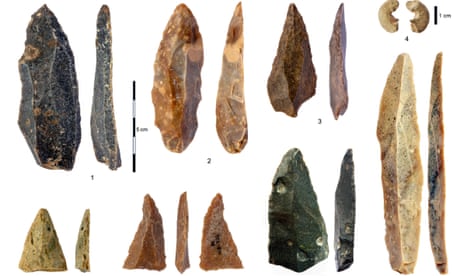Hannah Devlin Science correspondent -The Guardian
Edited by - Amal Udawatta,

Modern humans lived alongside Neanderthals for more than 1,000 years in Europe, according to research that suggests the two species may have imitated each other’s jewellery and stone tools.
Previously, it was known that humans and their ancient relatives existed at the same time on the European continent for more than 6,000 years and that the two species interbred on several occasions. But the extent of their interactions remains the focus of scientific investigation.
The latest paper suggests Homo sapiens may have coexisted with Neanderthals in France and northern Spain for 1,400-2,900 years before Neanderthals disappeared as a distinct species.
“In this region, there are a lot of similarities in the way that the two species were producing material culture and behaving,” said Igor Djakovic, a PhD student at Leiden University and first author of the analysis. “It lends credence to the idea that there was some kind of interaction going on.”
The team analysed a dataset of 56 Neanderthal and modern human artefacts (28 for each group) from 17 archaeological sites across France and northern Spain, as well as an additional 10 Neanderthal specimens from the same region. All samples had been radiocarbon dated.
Djakovic said that the chronological analysis showed the parallel appearance of certain artefacts at sites linked to both species, including the almost simultaneous appearance of perforated mammal teeth, thought to be a form of jewellery. Sites linked to both modern humans and Neanderthals also show a shift to more standardised blade-like stone tools. “This could potentially indicate an exchange of ideas or knowledge,” said Djakovic.
The authors used computational modelling to estimate the date ranges for these samples to infer the earliest and latest dates that these human groups may have been present at the sites. The work, published in the journal Scientific Reports, estimates that Neanderthal artefacts first appeared between 45,343 and 44,248 years ago, and disappeared between 39,894 and 39,798 years ago, shortly before Neanderthals became extinct. Modern humans were estimated to first appear between 42,653 and 42,269 years ago, and never left, suggesting an overlap of between 1,400 and 2,900 years.
The work does not shed light on whether humans had any role in Neanderthals’ demise. “The emerging consensus is that Neanderthals living in Europe were living in smaller populations,” said Djakovic. “You had larger populations of modern humans coming in and [the Neanderthals] were swallowed into these populations. You could make the argument that they never really disappeared.”
Prof Tom Higham, whose research previously indicated a similar overlap between modern humans and Neanderthals, said: “This study confirms previous work that shows a considerable overlap of several thousand years between different human populations (Neanderthals and modern humans) in western Europe, during which time these groups met one another and occasionally interbred prior to the final disappearance of Neanderthals around 39-40,000 years ago”.
… we have a small favour to ask. Millions are turning to the Guardian for open, independent, quality news every day, and readers in 180 countries around the world now support us financially.
We believe everyone deserves access to information that’s grounded in science and truth, and analysis rooted in authority and integrity. That’s why we made a different choice: to keep our reporting open for all readers, regardless of where they live or what they can afford to pay. This means more people can be better informed, united, and inspired to take meaningful action.

Comments
Post a Comment